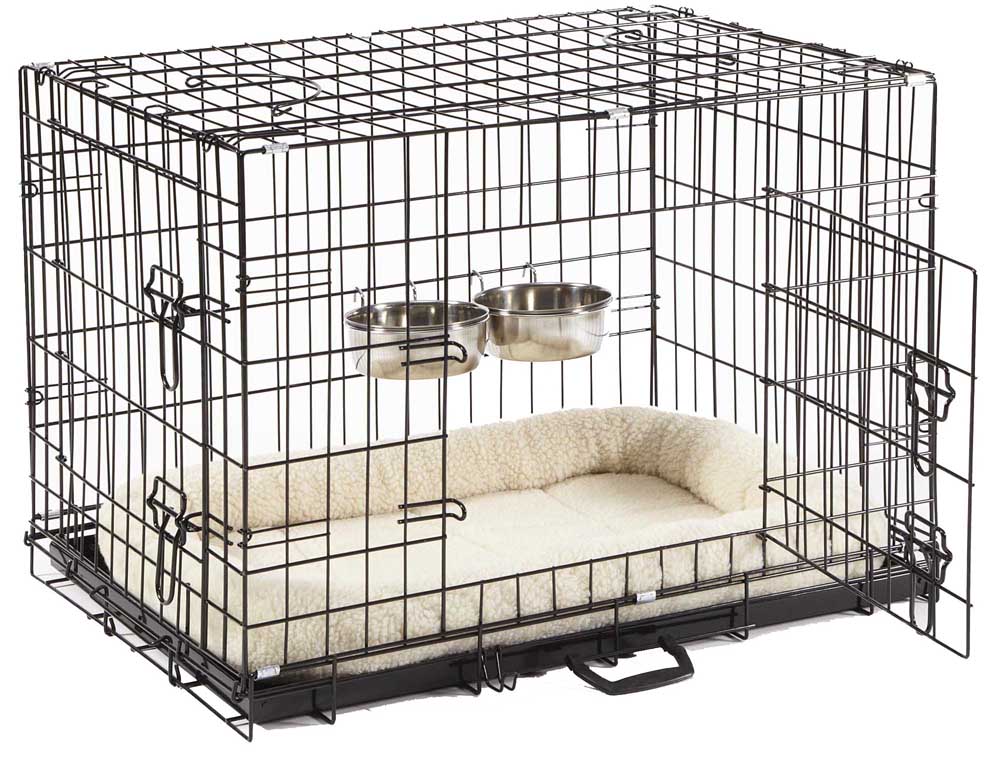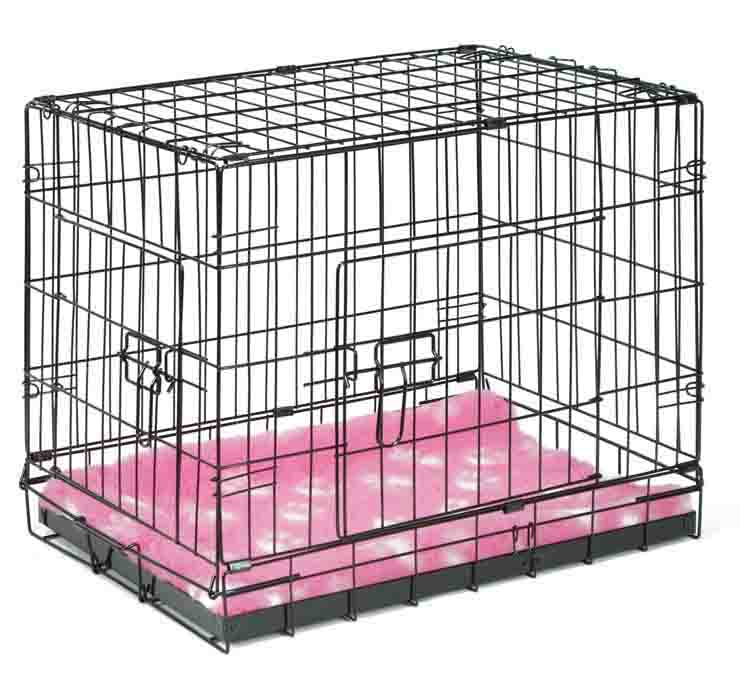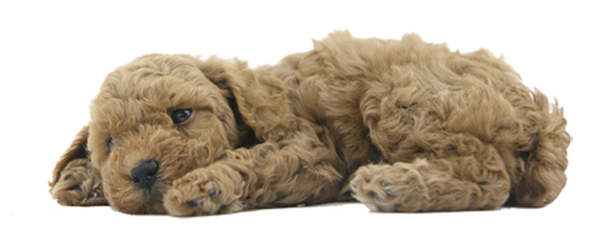Crate Training A Puppy
All images and text are © UK Pet Products Ltd. Images use embedded © protection

Crate Train Your Dog
Advice on what size to use, what to put inside the crate to help your puppy, time spent inside of the crate and the dangers of choosing the wrong size puppy crate which are often not mentioned.
Crate Train A Puppy – What UK Dog Crates Do Not Do
Most, if not all crates that are sold in the UK are not designed as containment wire crates for aggressive, distressed or anxious pets. Most use the wire crate as a safe place and to toilet train not to hold aggressive dogs.
Never leave any anxious or distressed pet alone unattended in any type of crate.
Dogs that are very anxious or aggressive when in their cage should never be left alone. They could not only damage the cage, they could and probably will injure themselves.
If you are reading this because your pup or adult dog is wrecking your house, chewing carpets, biting doors, chewing table legs or misbehaving every time you leave them alone. It is entirely likely. In fact, almost certain, they will do the same to a standard UK crate fairly quickly.
There are containment crates that are more like a dog jail, but they are much more expensive, heavy and hard to move. Ultimately, though, if they were not heavy, expensive items, is it fair to leave a pup in there struggling to escape and anxious?
What Size Puppy Crate Should I Buy To Crate Train A Puppy?
Probably the most useful tool of all time, to house-train a puppy, are crates. It is critical that you do not buy one that is too big, if your pup looks tiny inside it is far too big!
Training heavily relies on the instinct not to defecate where they sleep, I mean, that really is the instinctive nature they have from birth.
Of course, this doesn’t mean they can hold on forever, but they will do as long as they can. I want to help you learn how to use a crate effectively and more importantly safely and to build an association with the crate as a positive place. A Puppy should associate the crate as a safe place.
You can rely on solely the size of the crate to help your puppy learn where to go to toilet, and the crate will last 2 to 6 months until they grow out it.
Depending on breed, it should be 12″ longer in length than your new puppy is now when you buy the crate. A crate should be large enough for a dog or pup to be standing comfortably in the crate and be able to turn comfortably.
Measure from the tip of their nose to the base of their tail, then add 6-12″ that will suit his/her growing needs. They should be able to turn easily. They should be able to easily see the crate.
When this time is up, your young puppy will be clean in the house, you can then decide if you want to carry on using a crate. The crate may well be too small by now, and you can buy a larger crate with more space inside the crate. The dog’s crate can now be used with more freedom of space.
This will be a personal decision, but the now teenage pup will be used to having a crate, and they will feel like it’s their bedroom or den.
This will mean purchasing a crate to cater to their teenage to adult size growth. In my opinion, as explained later, this is by far the best method, if not the most cost-effective.
You may decide not to use it any more, but you may also find there is a time when they may miss their own safe space! The advantage of keeping your now adult dog crated is that it is ideal if you go on holiday or visit friends and family. You can take it on holiday, and they will settle much quicker having a familiar crate safe to stay in.
The second way is to buy a crate including a dividing panel, they are hard to find. The divider merely reduces the space to stop there being too much room and leaving a “toilet” area that your pup can use.
The third way is to buy a larger crate and use half of it to sleep and rest and the other half as a toilet area using weewee pads. It has disadvantages, but it does allow them to go when they need to. It also means to continue to use them, you will need to move the pads closer to the door and eventually outside.

Dog Crate Showing Our Vet Bed For Dog Crates
Extra Large Dog Crates Are For Large Adult Dogs!
One word of warning, the size of the crate you use matters a lot to your pets’ safety.
Each crate is made to house the appropriate size dog, and the specification changes each size. As the sizes go up from a small crate to the largest crate for big breeds, the gaps between the wires get much larger.
When I did sell crates, and we sold a lot. It was a frequent issue that new pups had been bought an XXL crate because “they need more space” for the puppy, and this creates another set of problems!
I read enough emails and listened to enough phone calls from customers to know why they bought an XXL crate for a Border Terrier pup, it was always to give them more space! I can understand this idea, but the reality is it will not help at all.
Here are the reasons you shouldn’t buy an XXL crate for your pup and not to buy a crate that is meant for Adult Dogs like the German Shepherd!
There are three main risks to using a crate that is too big. My expert advice from someone who has spoken to new owners who all had these issues using a large crate and small pups. These are real-world examples.
Larger dog crates are designed to have much larger gaps between wires. A pup will get leverage on a bite of 2 rows or columns of wire, and they are likely to bend under the constant bite pressure of a strong bite. This makes the crate weaker and easier for a dog to escape.
Once the wire starts to bend it is likely to snap and becomes a sharp object, plus there is the risk it could be swallowed. It also leaves a larger gap to bite the next row, weakening the crate even more.
If your dog crate is damaged similar to this, you should stop using it straight away. Often the new owner blames the strength of the crate, but the space between wires is the culprit, the gaps in the crate allow a dog to get full grip and increase their bite pressure.
The risk of getting a puppies paw or, worse still, your puppy gets their jaw trapped is far greater in a large dog crate due to the width and height of the wire gaps. If this happens, stay calm, get your pup to relax, normally they will get out. The same applies to an adult dog who is not comfortable in the crate.
The door size is far greater on the larger sizes. And still just two sliding locks, the bottom of the door is at a pups head height and will flex enough for them to get their head through. Or maybe escape, by opening the door far enough, whereas the correct size dog in the crate would be far too big.
First Introduction Of The Crate Plus Tips For Making It Positive
Once you select the correct size of the puppy crate, select the ideal location to place the crate in the home. It is recommended to purchase a crate that allows for your pet to grow into it during the first 6 months of house training until it becomes too small.
It may be more expensive, but it is the most effective approach.
When selecting the placement of the crate, it should be free of drafts, no heat source, and not in direct sunlight. The family should be around the crate.
Put the crate in an area that is accessible for your pet and you to open and close the door, and ideally, you should be near the crate.
It should be easy for your pup to enter the crate, get in and out of the crate, and easy to go back in the crate.
Most importantly, it should be a place where your dog feels included in their new family. It doesn’t need to be in the same location, as all types of crate sold in the UK are manageable by 1 or 2 people for the larger sizes.
Purchase comfortable bedding for your dog to place inside, as a normal pet bed that fits the crate. Alternatively, you can use a normal bed, or a precut non-slip vet bed covering it in case of accidents in the early days.
Introducing your dog to the crate should be a gradual process, not just placing them inside, but gradually increasing the time spent inside. Do not leave them alone straight away!
Place a treat inside the dog crate. This helps encourage your dog to go into the crate. Your dog may cry or whine, but do not leave the room immediately. Turn on the television and do not try to stop the whining to release them. Act as though it is normal. They need time in the crate.
Everything you do in the process, you are trying to train your dog or puppy to have a positive association with the crate this is not just locking them up on their first night is not that! Crate training can take days or a few weeks, you need to be patient.
Make sure the crate is their safe space. Make sure the dog crate provides a comfortable space, put the water bowls at the back of the crate, and never leave the crate without fresh water. Every time, you should leave some dog treats in the crate as you close the door.

The Next Steps, Your Puppy Or Dog In The Crate
Once the vet bedding is in, one of the good tricks is to put treats and dog toys into the crate before you close the door for any period of time. Feed your pup all their meals in the crate, all of these things re-enforce positive feelings towards a crate.
Remove the food if not finished it, and for water I recommend coup cups that bolt on to the crate wires.
You are a looking for a positive association to the crate. It’s important to spend time together close to the puppy crate with the door open, getting them used to it becomes a secure, safe dogs den for them. Make it their place for sleeping wherever you are. Use the crate as somewhere they can rest, never as discipline.
In the early days of owning a new pup, using a crate at night to train your dog or puppy it is essential to keep the crate in your bedroom at night, so you will be aware when your puppy may need to go outside.
It should only be short-lived, by the time a dog is 4 to 5 months old, they should be well on the way to being fully toilet trained.
Make sure your puppy goes out regularly and really praise them plus some treats when they go to the toilet and give them a small training treat.
Introduce the puppy to the crate as soon as they are brought home. Reward your dog for entering the crate and in and being calm. Try the door closed, then 10 minutes later open the crate door without a fuss
Choose a location outdoors for the puppy to go to the toilet. Treat them for defecating in the right place.
Wear your puppy out, lots of running chasing balls, Then allow them to sleep in the crate leaving the door open!
Then trial closing the crate door and leaving the room. Stay somewhere you can hear any activity, it is entirely likely your new pup will be pretty vocal, and whine wait awhile to see if they calm down. They may well whine to get out for some while, be patient. It should never be a punishment, of spending time in their crate for a reasonable length of time.
If your puppy does not relax, return to the room but do not make a fuss, just sit down and ignore them and leave it awhile and then leave again.
Repeat a couple of times. If they are calmer and are more confident, all good, if not, carry on repeating and intermittently release them without any fuss or reward and then put them back and try again.
It is tempting to make a fuss of your pet when you return, love that wagging tail and excitement to see you, but making a fuss does make them anxious when separated.
Repeat the crate and release procedure more times during the day before bedtime. Use a particular command to send your puppy to the crate. Then you can practice sending them to the crate using your regular command.
It is not really a good idea to leave your pup for prolonged periods when they are introduced to a crate, to get the full benefits of crate training it needs to start in small steps. Treats are really useful as puppy treats to help them get used to the crate.
Benefits Of Crate Training A Puppy
- Security and Comfort:
- Crate training provides a secure and comfortable space for puppies, mimicking the den-like environments their ancestors sought for safety.
- House-training Aid:
- Leverages a puppy’s instinct to keep their living area clean, aiding in house-training by encouraging them to wait until they are outside the crate to relieve themselves.
- Prevention of Destructive Behaviour:
- Reduces the likelihood of destructive behaviour by confining the puppy to a safe space, preventing them from chewing on furniture or other household items.
- Safe Travel:
- Familiarity with a crate makes travel less stressful for both the puppy and the owner, providing a secure and familiar environment during car rides.
- Establishment of Routine:
- Helps establish a routine for feeding, bathroom breaks, and sleep, contributing to a sense of predictability and stability for the puppy.
- Reduced Anxiety and Stress:
- Creates a sanctuary for the puppy, reducing anxiety and stress by giving them a designated space where they can feel safe and secure.
- Positive Association with Alone Time:
- Encourages independence and a positive association with being alone, as the crate becomes a comfortable retreat when the owner is away.
- Facilitation of Vet Visits:
- Familiarity with a crate facilitates vet visits, making it easier to transport the puppy and reducing stress during medical appointments.
- Prevention of Accidents at Night:
- Minimizes the risk of nighttime accidents by limiting the puppy’s movement to a confined space, promoting better bladder control.
- Assistance in Behavioural Training:
- Supports overall behavioural training by providing a controlled environment for reinforcing commands and desired behaviours.
- Transition to Larger Spaces:
- Serves as a transitional tool for gradually introducing puppies to larger spaces in the home, promoting a gradual adjustment to increased freedom.

0 Comments